TechRadar Verdict
The Moon i.1 has excellent bass, its detail is good and it's build is practical and neat. The amp also presents music well, creating a great sense of drama, which is fairly gripping, although occasional harshness in sound can affect vocals and bright-sounding melody instruments
Pros
- +
Excellent bass
- +
Good detail
- +
Neat and practical
- +
Presentation of music
Cons
- -
No recording output
- -
Harshness can occasionally affect vocals and bright-sounding melody instruments
Why you can trust TechRadar
While a £1,500 integrated is pretty upmarket for Arcam and Cyrus, it's the very start of the range for Simaudio, whose Moon products extend to distinctly high-end territory with such products as the vast and powerful Titan power amp. But then the Moon i.1 is not exactly a shrinking violet,
Its 50-watt rating is fairly modest by current standards and the unit is not at all daunting to behold. It's certainly neat and practical, though, as we shall see. In fact, it's every inch a classic no-frills integrated.
By far the dominant part inside the case is the mains transformer, which feeds the usual rectifier and capacitors and then the main amplifier board. This uses a mixture of through-hole and surface-mount components, with electronic switching of inputs (by integrated circuits, not relays), but a mechanical volume control accessed from the front via a good old-fashioned single-turn knob.
If all this suggests anything about the design approach, it is that it's thoughtful and not dogmatic, which must be a good thing. Unusually in an amp of this rating, Moon does without a heatsink.
Instead, the output transistors are mounted on the base panel, which is made of quite thick aluminium and functions adequately as a heatsink without any assistance – Rega does the same in some of its models.
In principle you might be able to overheat the amp with specific test tones, but in everyday use I can't see how that could ever happen. Inputs run to six, one being a frontmounted 'MP' socket, a mini-jack.

There's a preamp output, but no recording output and provision is made for wired, as well as a wireless remote control. And that's about it! It's really all about the sound here, so let's listen...
Sound quality
After that build-up, I'm glad to be able to report that this amp was, overall, another success. Our listeners pointed to several admirable virtues, including excellent bass and a good sense of drama.
There was the odd, slightly less-positive comment, though, including a slightly harsh presentation of vocals at times, especially female vocals. That bothered one listener much more than the others, but in the same sentence where he pointed it out, he also conceded that the Moon's presentation of the music was quite gripping and that this may be a very small trade-off for many listeners.
But it seems to be the bass that made the strongest impression. It's not only extended, it has detail, precision and a very good sense of pitch, a combination that's hard to find outside the high end.
It benefits all kinds of music, putting the upright bass and piano in a well-defined relationship in the Miles Davis track and giving full reign to the sound effects at the start of Michael Jackson's.
Even in the unaccompanied choral track, which certainly has the least overt bass of any in the blind presentation, the sense of a real church acoustic benefitted noticeably from the low-frequency confidence of this amp.
Midrange detail is good too but, perhaps, not quite the best. This quality is closely allied to stereo imaging and all the listeners felt that this was good, but with slightly restricted scale in both dimensions.
The 'presence' region (upper midrange/lower treble) is, perhaps, just a touch enhanced subjectively, although the bottom line is that one can very easily get lost in a piece of music played through this amp and whatever minor technical flaws it may have it is never less than a musical performer.
Follow TechRadar Reviews on Twitter: http://twitter.com/techradarreview
The TechRadar hive mind. The Megazord. The Voltron. When our powers combine, we become 'TECHRADAR TEAM'. You'll usually see this author name when the entire team has collaborated on a project or an article, whether that's a run-down ranking of our favorite Marvel films, or a round-up of all the coolest things we've collectively seen at annual tech shows like CES and MWC. We are one.
